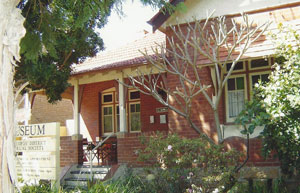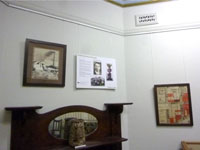
The aim of the museum is to inspire, educate and inform the Willoughby community and visitors, and to contribute to the conservation of the history and heritage of the City of Willoughby. It is housed in the 1913 Federation cottage, Boronia, at 58 Johnson Street Chatswood. The Museum serves as the base for the Society’s operations
Boronia is a modest cottage that is representative of the Federation era. The property was bequeathed to the Society in 1988 by Sonya Kirkham, a WDHS member who was tragically killed in a car accident in 1988. It lies within the South Willoughby Conservation Area, one of 12 in Willoughby City that have been established to protect Willoughby’s heritage and make sure that new development does not detract from the streetscape, landscape and character of the city.
Collections
The Willoughby Museum houses a number of collections and research information. This includes:
Permanent Collections
History of Willoughby (Hallway)
Pottery (Front Parlour)
Textiles (Front Parlour)
Carpentry, Ironwork & Tanning (Eric Wilsch Room)
Replica Kitchen & Laundry
Household items (Parlour & Breakfast Room)
Buzz [Meccano] (Breakfast Room)
Miscellaneous items (Rear Yard)
Themes
The Willoughby Museum focuses on four core themes:
-

Ronson Collection of Mashman Pottery Local industries and working lives: Our displays feature objects and photographs of the specific industries that helped build Willoughby’s economy and provided employment for its residents. In particular, we explore the history of the Mashman and Eaton potteries, our tanneries, the Buzza Products and Speedo factories in Artarmon, and the Hallstrom refrigerator factory in Willoughby.
- Domestic life: Displays in the kitchen explore the domestic work experiences of Willoughby residents from all socio-economic strata during the late 19th and 20th centuries. The focus is on the diversity and unique characteristics of Willoughby.
- Towns, suburbs and villages: We are developing improved presentations that will explore the factors that shaped the patterns of settlement in Willoughby, particularly urban development since the 1890s. The railway and tramway were key drivers of urban settlement from the 1890s, while more recently the private car and freeways have brought new challenges for local residents.
- Immigration and Ethnic Influences: While the Chinese have played a significant role as market gardeners since the 1870s, post-war migrations brought a dramatic influx of divergent ethnic groups to Willoughby City, notably Armenians, Italians, Japanese, Chinese, Koreans, Poles, Iranians and Indians since the 1950s. We will be exploring this theme through temporary exhibitions over the coming years.
Donations

With the assistance of a grant from Museums & Galleries NSW and a donation by the supplier CiCi Home Stylists of Artarmon, the Willoughby Museum installed a professional gallery hanging system in 2012. This view of the Jean Miller Room shows the improved presentations facilitated by the new system.
Paul Storm photoIf you have any items of historical interest relating to Willoughby City, such as photographs, art works, personal papers, reference books, or histories of local businesses, cultural, sporting, recreational, church or political organisations, our Society welcomes your contact concerning its possible donation. All items accepted into our collection will be suitably acknowledged.Please ensure that your check with the above contact regarding any potential donations. They are only useful to us if they comply with our Collection Policy and we have gained details of their provenance from you. Items left at the museum without such details only give us the problem of disposing of them.
